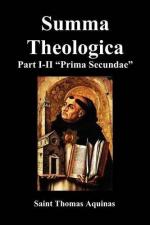Thirdly, it was fitting that these animals should be offered, that they might foreshadow Christ. Because, as the gloss observes, “Christ is offered in the calf, to denote the strength of the cross; in the lamb, to signify His innocence; in the ram, to foreshadow His headship; and in the goat, to signify the likeness of ‘sinful flesh’ [An allusion to Col. 2:11 (Textus Receptus)]. The turtledove and dove denoted the union of the two natures”; or else the turtledove signified chastity; while the dove was a figure of charity. “The wheat-flour foreshadowed the sprinkling of believers with the water of Baptism.”
Reply Obj. 3: Fish through living in water are further removed from man than other animals, which, like man, live in the air. Again, fish die as soon as they are taken out of water; hence they could not be offered in the temple like other animals.
Reply Obj. 4: Among turtledoves the older ones are better than the young; while with doves the case is the reverse. Wherefore, as Rabbi Moses observes (Doct. Perplex. iii), turtledoves and young doves are commanded to be offered, because nothing should be offered to God but what is best.
Reply Obj. 5: The animals which were offered in sacrifice were slain, because it is by being killed that they become useful to man, forasmuch as God gave them to man for food. Wherefore also they were burnt with fire: because it is by being cooked that they are made fit for human consumption. Moreover the slaying of the animals signified the destruction of sins: and also that man deserved death on account of his sins; as though those animals were slain in man’s stead, in order to betoken the expiation of sins. Again the slaying of these animals signified the slaying of Christ.
Reply Obj. 6: The Law fixed the special manner of slaying the sacrificial animals in order to exclude other ways of killing, whereby idolaters sacrificed animals to idols. Or again, as Rabbi Moses says (Doct. Perplex. iii), “the Law chose that manner of slaying which was least painful to the slain animal.” This excluded cruelty on the part of the offerers, and any mangling of the animals slain.
Reply Obj. 7: It is because unclean animals are wont to be held in contempt among men, that it was forbidden to offer them in sacrifice to God: and for this reason too they were forbidden (Deut. 23:18) to offer “the hire of a strumpet or the price of a dog in the house of . . . God.” For the same reason they did not offer animals before the seventh day, because such were abortive as it were, the flesh being not yet firm on account of its exceeding softness.
Reply Obj. 8: There were three kinds of sacrifices. There was one in which the victim was entirely consumed by fire: this was called “a holocaust, i.e. all burnt.” For this kind of sacrifice was offered to God specially to show reverence to His majesty, and love of His goodness: and typified the state of perfection as regards the fulfilment of the counsels. Wherefore the whole was burnt up: so that as the whole animal by being dissolved into vapor soared aloft, so it might denote that the whole man, and whatever belongs to him, are subject to the authority of God, and should be offered to Him.




